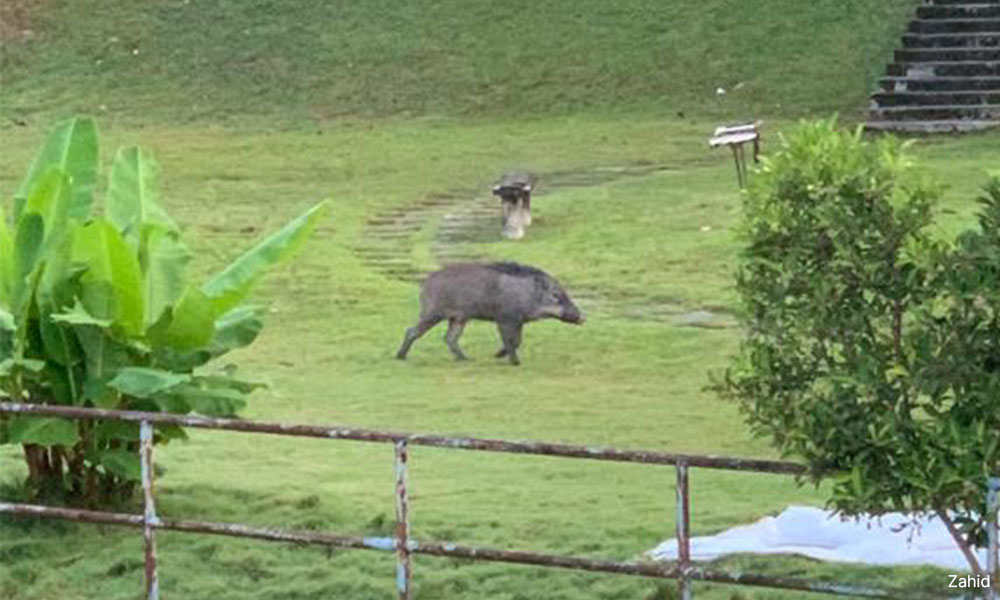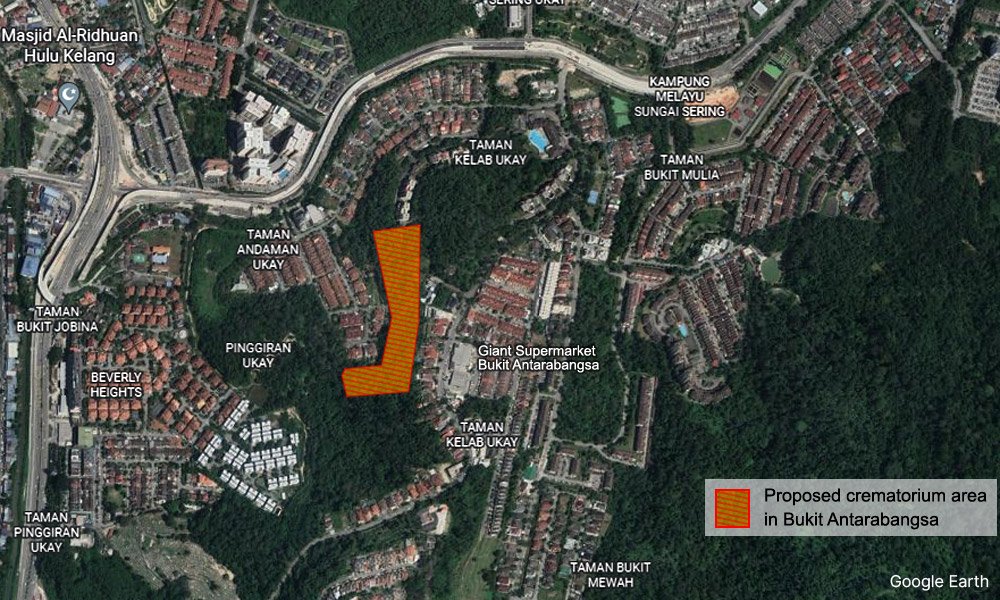The Ampang Jaya Municipal Council (MPAJ) has drawn criticism over its draft of the 2035 Local Plan for the municipality, which locals fear may cause flash floods and degradation of the surrounding forests.
Gazetted in 2011, the 2020 version will soon be replaced by the 2035 Local Plan. It previously underwent two amendments in 2013 and 2016.
The draft of the 2035 Local Plan comprises 91 proposals to rezone land status and raise land density. It also comprises proposals for a new highway and Mass Rapid Transit (MRT) 3 Circle Line alignment.
According to the draft plan, seven train stations - part of the MRT3 project - were said to have been proposed to be built in Ampang Jaya, Selangor, which is just east of Kuala Lumpur.
Speaking to Malaysiakini, representatives from local interest group AJ Rimba Collective cited health concerns and the risk of environmental damage due to projects affecting forested areas in the locality.
This includes projects such as a proposed crematorium along Jalan Kolam Air Lama, Ampang, the Kuala Lumpur Northern Dispersal Expressway (KL Node), the MRT3 project, and an alleged redevelopment of Kelab Darul Ehsan (KDE) located in Taman Tun Abdul Razak.
Further, objections heard at recent public hearings on Sept 20 and 22 highlighted confusion over the gazettement of land use in certain parts of the municipality.
This is especially the case for KDE - owned by Berjaya Land Bhd - which is allegedly poised to be converted into a residential area.
Documents sighted by Malaysiakini showed a purported redevelopment plan that appears to cut up the golf club into various development parcels. This includes building 243 bungalow units, 50 linked house units, as well as a “micro mini” clubhouse.
In the public hearing’s objections list, it was claimed that the 65-acre golf course’s land is shown on the draft plan as being gazetted for commercial use.

A move to do so would require two-thirds of support from stakeholders to change its land use from recreational to residential.
Berjaya Lands invited residents to a town hall meeting on the issue scheduled on Sept 17, but the meeting was later cancelled.
This Tuesday (Oct 4), the third session of MPAG’s public hearing concerning infrastructure issues will be held.
The session is expected to be chaired by Izham Hashim, who is the Selangor state executive councillor in charge of infrastructure and public amenities, agriculture modernisation, and agro-based industry.
‘No real effort’ in draft plan
Local resident and retiree Abdul Aziz Ibrahim lamented that there is a lack of care in drafting the local plan, believing authorities are doing so simply because “it’s required by the law.”
“They have to put it up every five years. So they do it, but as the Malays say, ‘Lepas batuk di tangga’ (to do something half-heartedly).
“They think people won’t care and just simply agree to it. To me, they make no real effort to really put up a good local plan. No details, nothing,” he said.
Aziz said his residence in Taman Hijau faces “man-made floods” and he has suggested MPAJ do more to monitor the waterways throughout the municipality.
With data on water flow, he said, the council and developers can run simulations and identify the areas worst hit by floods.
He claimed that even Brinchang town in Cameron Highlands - the highest in Malaysia at 1,450m above sea level - faced floods “because of poor planning, poor design, and poor implementation”.
Another local resident, who only wanted to be identified as Sara, added that it is the government’s role to find a solution that will cater to all.
“You need to know what’s the implication when there’s a heavy downpour and all this water is cascading (into one area),” she said.
Additionally, AJ Rimba coordinator Noina Baharuddin pointed out that the forests of Ampang Jaya are a water catchment area - where water is collected by the natural landscape.
The Ampang Impounding Reservoir, built in 1892, was the first reservoir to supply drinking water to Kuala Lumpur and is located in the forests of Ampang Jaya and once supplied 37 million gallons to the city’s population.
Water supplied to the Klang Valley is now sourced elsewhere to meet the demand of the growing population.
Citing the 1993 Highland Towers tragedy, Aziz claimed that developments still tended to pursue projects with the aim of economic development - despite guidelines stated in the National Physical Plan.
He claimed that there were previous plans to level the hill nearby his house where developers were to build bungalows.
Developers should not attempt to change the natural topography of an area, he said.
“That means if there is a river, you must leave it there. If the slope is (as) such, leave the slope as such.
“This is why we have all sorts of natural disasters. But our natural disasters… are all man-made,” he added.

Malaysiakini previously reported that according to the Ministry of Housing and Local Government, 49 percent of local authorities revealed their lack of slope management expertise and 81 percent do not implement maintenance.
The ministry’s circular sighted by Malaysiakini did not disclose the identities of the 41 local authorities but stated that the same 49 percent (about 20) also lacked a governance structure to manage slope and landslide-related issues.
Separately, the circular reported that as of December 2020, there were 837 slopes nationwide, of which, 35 percent or 292 slopes have a history of slope failure - with states having the highest number of slopes being Selangor, Pahang, and Negeri Sembilan.
However, this total is based on information obtained from only 95 local authorities out of 155 nationwide.
Animal sightings
Aziz, who lives on the edge of Taman Hijau, also told Malaysiakini that he has spotted wild animals such as wild boar, stags, and otters - in the area with higher frequency as of late.
He claimed there have even been sightings of panthers coming closer to the residential area.
Meanwhile, on the other side of Ampang, residents in Taman Bukit Indah - less than 4km away - have reported sightings of animals such as wild boar and deer.
“When I came back from school, I came across this (wild boar) roaming the side of the road near Setia Hills,” said a teacher residing in the area, who only wanted to be known as Zahid.

“Two nights ago, it rummaged through my house’s trash can and my neighbour’s trash can in front of my house. I’m not even sure if the authorities - MPAJ - are aware of this,” he added.
Zahid, who has lived in Taman Bukit Indah since 2014, said it could be the first time a wild boar ventured into his neighbourhood based on the response he got from his neighbourhood WhatsApp group.
Proposed crematorium
Meanwhile, Ampang Jaya residents are unhappy about plans to build a crematorium on the Ampang/Ulu Klang Hindu and Chinese cemeteries along Jalan Kolam Air Lama within walking distance from Taman Hijau.
Speaking to Malaysiakini, Noina pointed out that while the land use is indeed gazetted for the proposed crematorium, its proposed location did not fit conditions “in this day and age”.
“We are not against development per se, but we are definitely against non-sustainable development and (especially) if it’s not adhering to the laws and regulations that are already out there for everybody to adhere to,” she said.
This was echoed by resident Sara, who noted that the proposed crematorium would be in close proximity to a food court.
The Selangor Planning Guidelines and Standards Manual (Third Edition) states that at least 0.6ha of space is required to erect crematoriums - with a compulsory buffer zone of 6.1m.
According to Sara, there are guidelines against building a crematorium in a populated area - with crematoriums typically being out of town.
“Is our area considered out of town? A crematorium must be away from existing and future buildings.
“There is a food court there, for heaven’s sake! Can you imagine having your teh tarik there and ashes flying?” said Sarah.
Previously, the crematorium was mooted to be built in Bukit Antarabangsa, which is 6km away, before it faced objections from residents in that area.

Religious groups have also objected to the proposed site of the crematorium.
Hindu Cemetery Crematorium Ampang Association honorary chairperson Indrakaran T Karthigesu reportedly claimed the burial grounds lacked sufficient space to host a crematorium.
“This is an old site with limited space. We have to allocate the remaining space for future burials.
“The council is already building an anaerobic digestion plant on the grounds. A crematorium will take up more space,” he told The Star.
Last year, Selangor Menteri Besar Amirudin Shari announced plans to add two crematoriums in Selangor to expedite the cremation process for the remains of non-Muslim Covid-19 victims in the state.
He said to date, only one of the state’s crematoriums - under the Klang Municipal Council - could be used for such services.
“This is one of our efforts to expedite the cremation process in a cost-effective manner.
“The cremation services at the local authority’s crematorium will be carried out with the help of non-governmental organisations,” he reportedly said.
The state government similarly declared last year that three more crematoriums were to be built in the state with a target to complete the projects in two years.
At present, seven crematoriums can be found in Selangor – two each under the Petaling Jaya and Shah Alam city councils. The Klang Municipal Council, Subang Jaya City Council, and Sepang Municipal Council all have one each. - Mkini

No comments:
Post a Comment
Note: Only a member of this blog may post a comment.